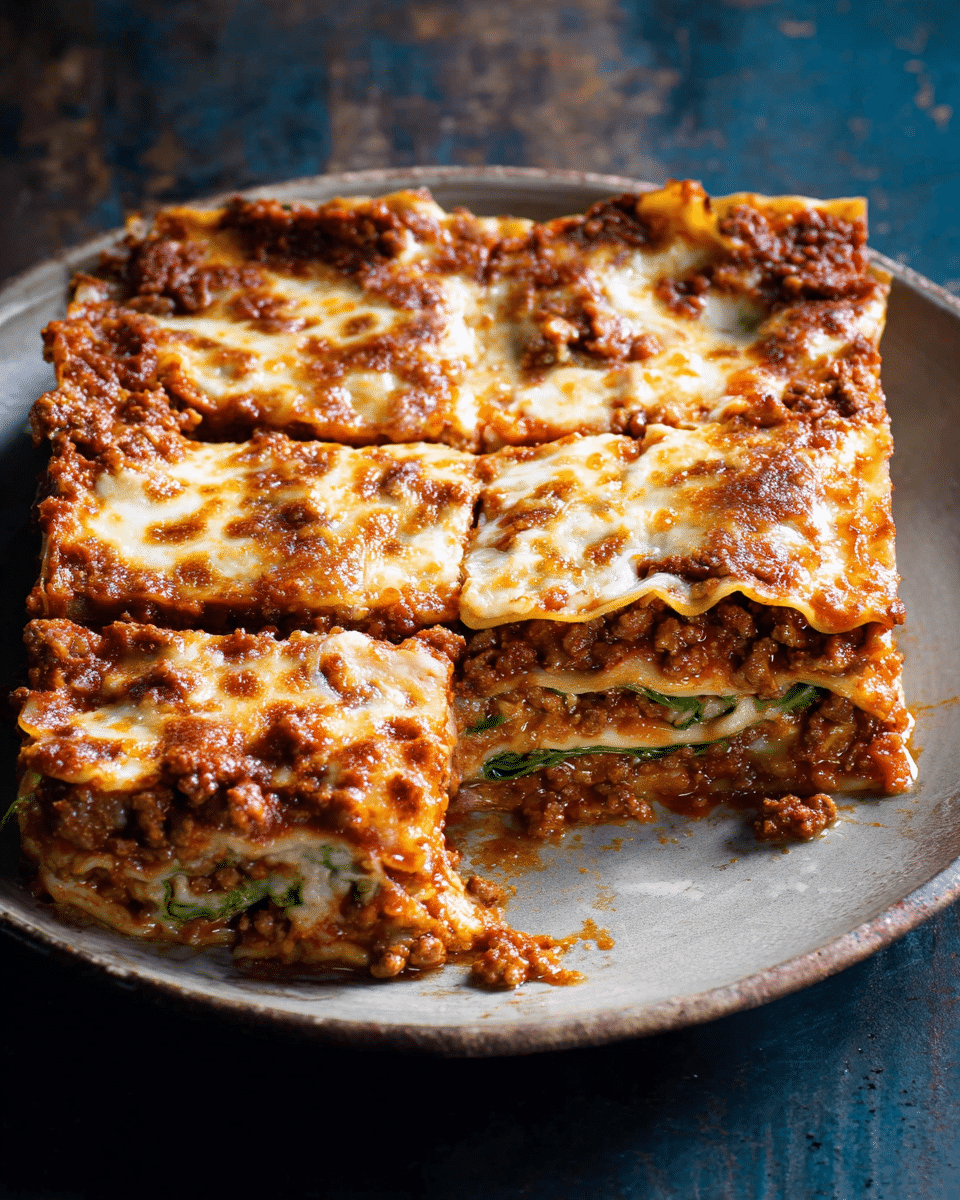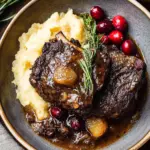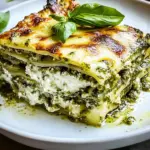This Lasagna Bolognese is the epitome of comfort food. With rich layers of flavorful Bolognese ragu, creamy bechamel, and homemade spinach pasta, it’s a meal that will warm you from the inside out. The complexity of flavors, from the savory beef and pancetta to the nutmeg-scented bechamel, creates a luxurious dish perfect for any special occasion.
Making lasagna from scratch is a labor of love, but the results are worth every minute. While the Bolognese sauce improves with time, the fresh spinach pasta adds an earthy touch that perfectly complements the rich sauce. The layers of cheese, sauce, and pasta meld together in a hearty and satisfying bite that’s simply irresistible.
Full recipe:
Ingredients:
-
1 large carrot, finely chopped
-
1 large celery stalk, finely chopped
-
1 large onion, finely chopped
-
7 oz pancetta, cubed
-
2 lbs ground beef (minced)
-
1 cup chicken stock
-
1 cup white wine
-
2 cups passata (tomato puree)
-
2 cups whole milk
-
1 tablespoon olive oil
Spinach Pasta (optional, can use store-bought)
-
7 oz fresh spinach
-
2 cups plus 2 tablespoons Italian 00 flour
-
2 medium eggs
-
1 egg yolk
Bechamel Sauce:
-
5 tablespoons unsalted butter
-
5 tablespoons flour
-
4 cups whole milk
-
¼ teaspoon freshly grated nutmeg
-
Salt and pepper to taste
-
Parmigiano Reggiano, for grating
Directions:
-
Prepare the Bolognese sauce the day before: Finely chop the carrot, celery, and onion. Cut pancetta into small cubes. Heat olive oil in a large pot and sauté vegetables and pancetta for 5-10 minutes. Add ground beef and cook until browned. Pour in white wine and cook for 1-2 minutes. Add passata and stock, then simmer for 2 hours. Add milk, cover, and simmer for another 2 hours. Season with salt and pepper.
-
Prepare spinach pasta (optional): Wilt spinach in boiling water, rinse in cold water, squeeze out excess moisture. Blend spinach, eggs, and egg yolk into a smooth puree. Add flour, knead into dough, wrap, and refrigerate.
-
Make the bechamel sauce: Melt butter in a saucepan, add flour, and cook for 1 minute. Gradually whisk in milk, add nutmeg, salt, and pepper, and cook until thickened.
-
Boil and blanch the pasta sheets, then layer them with Bolognese sauce, bechamel sauce, and Parmigiano Reggiano in a baking dish.
-
Bake at 200°C (400°F) for 30 minutes until golden and bubbling. Let sit for 10 minutes before serving.
Prep Time: 1 hour | Cooking Time: 4 hours | Total Time: 5 hours | Kcal: 849 kcal | Servings: 6 servings
The History of Lasagna Bolognese
The history of Lasagna Bolognese is as rich and flavorful as the dish itself. Lasagna, in its various forms, has been around for centuries, with its origins tracing back to Ancient Greece and Rome. However, the version of lasagna that we recognize today as Lasagna Bolognese has its roots firmly planted in the city of Bologna, Italy, during the late Middle Ages.
The Bolognese sauce, known as ragù alla Bolognese, has a long history and is considered a fundamental part of the cuisine in Bologna. It’s believed to have originated in the 18th century when a chef named Imola, from the town of the same name near Bologna, created a meat sauce with minced veal, butter, and broth. Over the years, this sauce evolved, incorporating ground beef, pancetta, and tomatoes, with the addition of wine and milk becoming a standard in modern Bolognese recipes.
When paired with layers of pasta and creamy bechamel sauce, this rich and savory meat sauce became the heart of Lasagna Bolognese. The traditional recipe has remained largely unchanged over time, with small variations depending on regional preferences. The use of spinach pasta is one such variation that adds a vibrant color and extra flavor to the dish, although some recipes may use regular egg pasta sheets.
The Essential Components of Lasagna Bolognese
A traditional Lasagna Bolognese is made up of three key components: the Bolognese ragu, the bechamel sauce, and the pasta. Each element plays a vital role in creating the perfect lasagna, contributing to the overall richness and depth of flavor.
Bolognese Ragu: The Bolognese sauce is the star of this dish. It’s made by slow-cooking ground beef and pancetta with aromatics such as onions, carrots, and celery, before adding white wine, tomato passata, and stock. The sauce is simmered for several hours to develop deep, complex flavors, which are then enhanced by the addition of milk at the end of cooking. This results in a velvety, hearty sauce that forms the foundation of the lasagna.
Bechamel Sauce: Bechamel, a creamy white sauce made from butter, flour, milk, and a hint of nutmeg, adds a luxurious smoothness to the lasagna. It complements the richness of the Bolognese sauce and helps to bind the layers of pasta and sauce together. The balance of flavors between the savory ragu and the creamy bechamel is one of the key factors that makes Lasagna Bolognese so indulgent and satisfying.
Spinach Pasta: While many lasagna recipes use store-bought pasta sheets, traditional Lasagna Bolognese often includes homemade spinach pasta. The fresh spinach dough adds an extra layer of flavor, as well as a beautiful green color to the dish. The dough is rolled out thinly, blanched, and layered with the ragu and bechamel sauce. The homemade pasta, when combined with the sauces, creates a delightful texture and flavor profile that’s simply unmatched by store-bought alternatives.
Making Lasagna Bolognese from Scratch: A Labor of Love
Making Lasagna Bolognese from scratch is undoubtedly a time-consuming process, but the results are well worth the effort. The slow-cooked ragu sauce is the heart of this dish, and it requires several hours of simmering to develop its full flavor. Similarly, the homemade spinach pasta dough takes time and patience to prepare, as it needs to be kneaded and rested before being rolled out and blanched.
One of the best aspects of making Lasagna Bolognese from scratch is that it can be prepared in stages. The Bolognese sauce and the spinach pasta dough can be made the day before, allowing the flavors to meld and making the assembly of the lasagna much easier. In fact, the ragu often tastes even better the next day, as the meat absorbs more of the sauce’s flavors.
Assembling the lasagna is the final step, where you layer the pasta sheets, Bolognese sauce, and bechamel sauce. Each layer is carefully spread and topped with a generous amount of grated Parmigiano Reggiano. After baking in the oven, the lasagna develops a beautiful golden crust on top, and the layers become wonderfully melded together, creating a comforting, mouthwatering dish.
The Importance of Quality Ingredients
While the process of making Lasagna Bolognese is intricate, the quality of the ingredients used is just as important. To achieve the best results, it’s essential to use high-quality meats, fresh vegetables, and good-quality pasta.
Beef: For the Bolognese ragu, using high-quality ground beef is crucial. The meat should be lean yet flavorful, as it will be the base of the sauce. Some recipes may even use a mix of beef and pork for added richness.
Pancetta: Pancetta, an Italian cured meat, adds depth and richness to the ragu. Using a good-quality pancetta, preferably from an Italian deli or specialty store, makes a significant difference in the overall flavor of the dish.
Passata and Tomatoes: When making the ragu, using high-quality passata (strained tomato puree) or canned tomatoes is essential. Brands like Mutti or Cirio are often recommended for their rich flavor and consistency.
Parmigiano Reggiano: The grated Parmigiano Reggiano used to top the lasagna adds a sharp, nutty flavor that complements the richness of the sauces. Always opt for authentic Parmigiano Reggiano for the best flavor.
Lasagna Bolognese and Its Cultural Significance
Lasagna Bolognese is not just a dish; it’s an essential part of the culinary tradition of Bologna and the Emilia-Romagna region. The dish is a staple in Italian households and is often served on special occasions like Christmas, Easter, or family Sunday dinners. In Bologna, where the dish originated, lasagna is a source of pride, and its preparation is a time-honored tradition that brings families together.
The dish is also a symbol of Italian hospitality, as it is often prepared in large quantities to share with friends and family. The process of making Lasagna Bolognese is a communal activity, and many Italian families pass down their recipes and techniques through generations. The dish is also frequently served at festive gatherings, where it is enjoyed alongside crusty bread and perhaps a glass of wine, making it a true celebration of Italian food and culture.
Health Benefits of Lasagna Bolognese
While Lasagna Bolognese is undoubtedly a rich and indulgent dish, it does offer some health benefits when enjoyed in moderation. The dish is high in protein, thanks to the ground beef and pancetta, which are excellent sources of this essential macronutrient. The spinach pasta provides fiber and essential vitamins, including Vitamin A and Vitamin K, which are important for maintaining good health.
The use of fresh vegetables, like carrots, onions, and celery, in the ragu sauce also adds a boost of nutrients, including antioxidants that help protect the body from oxidative stress. Additionally, the bechamel sauce, while rich in fat, provides a creamy texture that balances the savory flavors of the ragu, making the dish a well-rounded meal.
Conclusion
Lasagna Bolognese is a timeless dish that showcases the best of Italian cuisine. With its layers of rich Bolognese ragu, creamy bechamel, and homemade spinach pasta, this dish offers a complex, satisfying flavor profile that will leave you craving more. While it requires time and patience to make from scratch, the result is a comforting, indulgent meal that’s perfect for sharing with loved ones. Whether you’re making it for a special occasion or simply to enjoy a comforting meal, Lasagna Bolognese is a dish that brings people together and celebrates the art of Italian cooking.
If you’ve never tried making Lasagna Bolognese, it’s definitely worth the effort. The flavors and textures that come together in each bite are unmatched by any store-bought lasagna, and the satisfaction of creating this classic Italian dish from scratch is truly rewarding. So gather your ingredients, prepare your sauces, and get ready to enjoy one of the most beloved dishes in the world of Italian cuisine!






